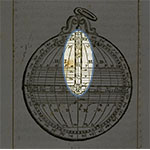An accessory in many astronomical and mathematical instruments, the cursor consists of a small block or ruler, smooth or graduated, which, as its name indicates (from the Latin cursorem = corridor), slides on another part of the instrument. The cursor has a dual purpose: to select a numerical value before a measurement or calculation, or, conversely, to facilitate the read-out of the values measured and calculated with the instrument.
Ancient astronomical instruments fitted with cursors include the universal astrolabes designed by Abû Ibrâhîm ibn Yahyâ al-Zarqâlî (c. 1029-c. 1087) and Juan de Rojas Sarmiento (16th C.). In both, the cursor consists of a small graduated ruler sliding on the alidade, which is also graduated; the cursor always remains in perpendicular. Typically, the cursor would slide on the alidade up to the point where the coordinates of a celestial body would appear on the grid of meridians and parallels etched on the instrument. By jointly rotating the cursor and the alidade by a suitable angle, the user could convert those coordinates into those of another reference system without resorting to tedious trigonometric calculations.
Recent examples of cursors are the moving part of the slide rule used by engineers before the advent of pocket calculators and the sliding part of the workshop caliper on which the nonius scale is engraved.








